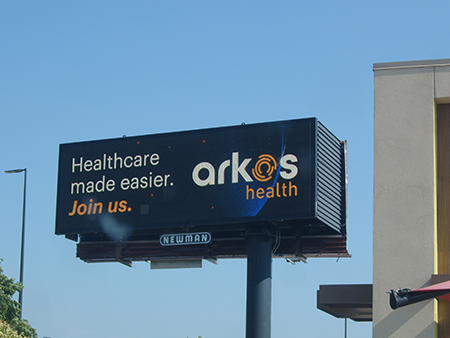
Why Less is More for Billboard Design
Billboards are the perfect high-impact canvas that delivers messages straight to your audiences. They are hard to miss and easy to remember, but attention spans are short—especially when audiences are in motion.
You may be called to make your billboard design the best it can be with crowded visuals, lengthy ad descriptions, and an overbearing color scheme. Simplicity is key to success in advertising out-of-home (OOH).
Any OOH design must adhere to the informal, 7-second rule. Most viewers only glance at a billboard for 5-7 seconds, so messaging must be quickly readable and digestible at a single glance. There is no room for clutter in a world vying for everyone’s attention—especially with shortening attention spans due to increased digital viewing time.
Common Billboard Design Mistakes
While it may be tempting to treat a billboard like a digital ad or print flyer, this approach often backfires since its nature is not fit for such clutter. Audiences are either driving by at 60 miles per hour, walking through bustling transportation hubs, or glued to their phones. That means cluttered or confusing designs can result in zero retention.
Below are the most common design missteps advertisers should avoid:
1) Overloading with Text
One of the biggest mistakes is cramming too much information onto a billboard. Some brands try to squeeze in a headline, subhead, body copy, website URL, hashtags, and fine print all in a single advertisement. Unfortunately, more than a few words will likely go unread.
2) Using Small Fonts
Fonts that look great on a screen often don’t translate to a 14-foot-tall board viewed from 400 feet away. If your text isn’t legible at a distance, it might as well not be there at all. Especially with audiences in motion, your message will go to waste.
3) Poor Color Contrast
A billboard needs to be visible under bright sun, rain, headlights, and shadows. Low-contrast color pairings like yellow on white and red on black can get easily washed out or become completely illegible, depending on conditions.
Core Design Principles of Effective Billboard Design
Now that you know what makes for an ineffective billboard ad design, here are the essential principles that guide high-performing OOH placements:
1) One Clear Message
A great billboard communicates one idea, not a list of features or multiple CTAs. When you try to say too much, the viewer has a difficult time retaining the key pieces of your message. Whether you’re promoting a local business or a new product, your message should be instantly recognizable and easy to summarize.
2) Large, Bold Fonts
Your billboard message’s design should have a font that is legible from 300-500 feet away. The trick to doing this is using bold, sans-serif fonts and avoiding overly stylized or script fonts. Script fonts can be hard to lead at a distance, especially when moving at 60 mph.
3) High-Contrast Colors
Color contrast is essential for both visibility and impactful messages. Use bold color pairings that pop in daylight and in poor weather. The background and text should never dilute each other but rather complement each other for maximum readability and retention rates.
Your Billboard is Ready for Design
Upon understanding what you shouldn’t and should do, your advertisement is ready to take on the busy public centers and jam-packed airports. Move quickly and reserve your OOH placement before the competition does!

